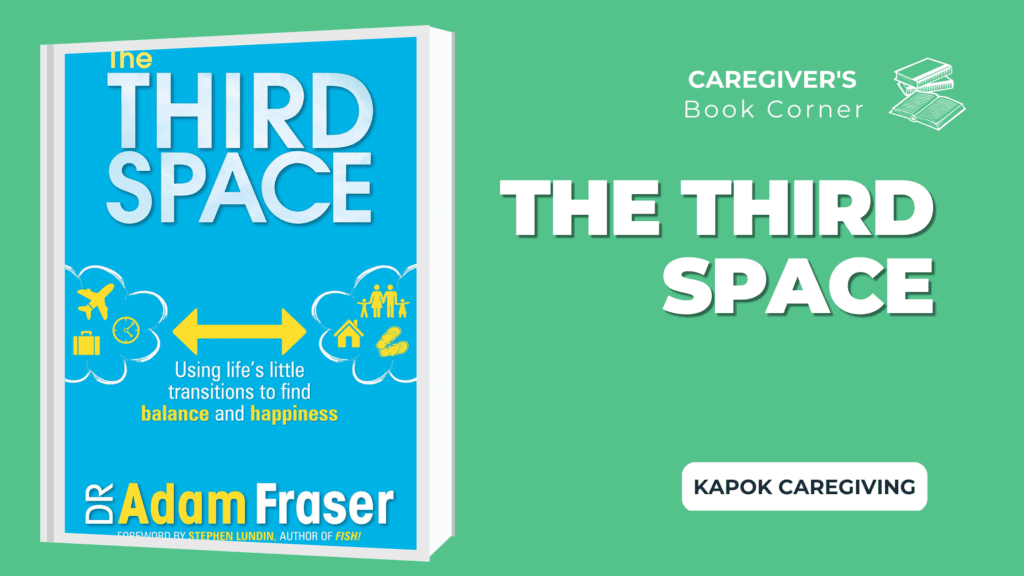
I find myself spending a lot of time with self help books (although, admittedly, I listened to this one as an audiobook on Audible). That’s partly because I’m always looking to improve. Mostly though, I’m curious. I love seeing what ideas there are out there and which ones actually make sense.
Ideally, I want to find powerful concepts that can actually help caregivers.
There are some amazing ones out there, ones that really work. There are also plenty that don’t apply or that are just a rehash of familiar ideas.
Adam Fraser’s third space concept is one that sounded fascinating right from the beginning.
Feeling Overwhelmed?
Check out our Caregiving Consulting service for personalized support and guidance.
The Concepts
The term third space or third place is most often used in sociology to refer to the places that people spend time between home and work. In this context, third spaces can be almost anything, including a gym, a nightclub, a church, a park, or even the hairdresser’s.
Such third spaces provide a chance for people to enjoy themselves and connect with others – particularly people outside their family.
In his book The Third Space, Adam Fraser uses the idea in a slightly different way. He talks about the little transitions that we make in life.
Essentially, he’s saying that instead of going from the first space (often home) to the second space (often work), you need some type of transition space in the middle.
This isn’t just limited to going from work to home though.
The idea can also be applied to much smaller transitions, like going from a meeting to working at your desk or from being with your aging parent to cooking dinner for your kids.
The video below is the author’s summary of the idea.
The main theme is simple – you need to reflect, rest, and reset as you move from one task to another. In particular:
- Reflect: Reflect involves focusing on the situation that you’re leaving. Like, for work, this might include running through what went wrong in the day, where the challenges were, and what you might do better tomorrow.
- Rest: This is where you stop focusing on the past. Where you intentionally put that baggage down and let go. What this looks like depends on who you are and what you love. For some people, it might be a walk or some yoga. Others might go to the gym or play a video game.
- Reset: Reset focuses on getting you in the right mindset for the next situation. This includes thinking about the energy you want to bring to the table and what you want out of this part of your day. You might also think about the people you will be interacting with, like your aging parents. What may their day have been like? What challenges may they have faced?
Is the Book Good?
The book is well-written and easy to read, so it’s good in that sense. The ideas that Dr. Fraser talks about can be powerful as well.
The biggest issue is the length.
Like many self-help authors, Dr. Fraser spends a lot of time arguing for his theory and backing it up with anecdotes. Because of this, it takes a long time to actually get anywhere.
This is particularly frustrating for caregivers – as you probably don’t have much time to spare.
Does The Third Space Apply To Caregivers?
The Third Space definitely isn’t written for caregivers.
That’s immediately obvious, as Dr. Fraser spends so much time talking about work versus home transitions, without much mention of alternative patterns.
Still, some of the principles are relevant.
You could use Dr. Fraser’s approaches as a way to transition from supporting someone else to caring for yourself, and back again.
You’d probably need to be much more fluid and creative about doing so than Dr. Fraser suggests. Still… perhaps some of his ideas could help.
If you’re interested in giving the book a try, you should be able to access it through Audible’s free trial (if you haven’t signed up previously).
My Personal Perspectives
I did enjoy The Third Space, up to a point. However, there are a few important things to talk about.
Dr. Fraser’s Anecdotes
Adam Fraser includes many anecdotes from people he’s helped.
These were useful, especially at the beginning of the book, as they show different ways that the concepts can be applied and how solutions look different for different people.
They do get a bit same-old after a while though. As one reviewer pointed out, the anecdotes start to feel a little like informercials for the power of Dr Fraser’s concepts.
That issue made the book harder to enjoy.
The Repetition
Some self-help authors basically repeat the same ideas in a slightly different way.
There are good reasons for this, like reinforcing their point, providing evidence, or helping readers to understand something complex. However, the style is also very frustrating.
The Third Space is particularly bad in this arena. Dr. Fraser has many chapters introducing and ‘proving’ his third space theory. I was frustrated long before he got to the practical side of his theories. And, honestly, the practical side isn’t that different than the rest anyway.
Lack of Flexibility
The first two problems I can forgive. They’re annoying, but are a common feature of self-help books. The third issue is much more significant – Dr. Fraser’s lack of flexibility and creativity.
He periodically says that the third space should be customized to the person and that it can look very different depending on the individual. This was obvious in some of his examples too.
But, when actually teaches what to do, his assumptions of what works get quite rigid.
This was particularly obvious in his chapter on working from home, as he drones on and on about the importance of routine. While routine is powerful for many people, it’s an oversimplification to view routine as the be-all-end-all.
Okay, I’ll admit that the routine stuff got my hackles up.
I’ve worked from home for close to a decade now and I’ve tried the routine thing. It doesn’t work for me. Nor does trying to have a 6- or 8-hour workday, then stopping and switching to family time.
I find I do much better if I’m creative and flexible. That often means doing a 4-hour block of work in the morning, going to enjoy the day, then coming back to it later on. Some days things are different. Sometimes I start early and I’m done by 2pm. I’ve even been finished by noon before.
Caregivers need this type of creative flexibility too. Care recipients often won’t easily fit into the routine you have in mind, so being able to adapt quickly and well is crucial.
If a routine works for you, that’s fantastic. If not, you’ll need to spend time tweaking Dr. Fraser’s approaches until you find versions that work for your needs.
What You Can Do
Adam Fraser has a TED talk on his concepts. This is almost 10 years old, so it’s not as up-to-date as his book (which has an added chapter on working from home due to all the challenges from COVID).
However, the TED talk is much more digestible than the book and tells you most of what you need to know.
One of the biggest takeaways is the idea of pausing between spaces (or tasks), giving yourself time to switch mentally from one thing to another.
If you don’t live with the person you’re supporting, you can probably use some of Adam Fraser’s examples directly, like going for a walk after seeing your aging parent or going to the gym, so that you don’t take the stress back home with you.
If you live with the senior, things get trickier.
Many aspects of what Adam Fraser talks about won’t be relevant, as he focuses on routine and separation between the different parts of your life. Those approaches don’t work so well for many caregivers.
However, you may be able to take a few minutes between tasks to clear your head and make sure you engage in the right mental state.
Alternatives to The Third Space
Much of what Adam Fraser talks about is basically a twist on the idea of mindfulness.
So, you could look for books and techniques that focus on mindfulness, particularly in unpredictable situations.
Kristen Neff’s work on mindful self-compassion springs to mind, as she often talks about ways to be kind to yourself in the moment. This doesn’t involve the same type of transition that Adam Fraser highlights, but could be more helpful to many caregivers.
I also like the book Reality Slap (called When Life Hits Hard in some markets). This one focuses on Acceptance and Commitment Therapy, which includes some aspects of mindfulness and approaches to help people get into life.
Reality Slap has its limits too, but I love how it focuses on situations that are difficult – and how it includes a variety of techniques. Books with multiple techniques are much more powerful than those that spend the entire time banging on about the same point.
Feeling Overwhelmed?
Check out our Caregiving Consulting service for personalized support and guidance.

Leave a Reply